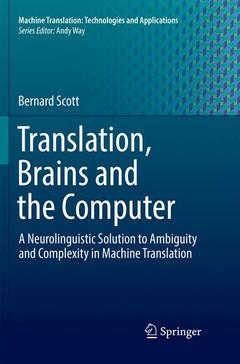Translation, Brains and the Computer, Softcover reprint of the original 1st ed. 2018 A Neurolinguistic Solution to Ambiguity and Complexity in Machine Translation Machine Translation: Technologies and Applications Series, Vol. 2
Auteur : Scott Bernard

This book is about machine translation (MT) and the classic problems associated with this language technology. It examines the causes of these problems and, for linguistic, rule-based systems, attributes the cause to language?s ambiguity and complexity and their interplay in logic-driven processes. For non-linguistic, data-driven systems, the book attributes translation shortcomings to the very lack of linguistics. It then proposes a demonstrable way to relieve these drawbacks in the shape of a working translation model (Logos Model) that has taken its inspiration from key assumptions about psycholinguistic and neurolinguistic function. The book suggests that this brain-based mechanism is effective precisely because it bridges both linguistically driven and data-driven methodologies. It shows how simulation of this cerebral mechanism has freed this one MT model from the all-important, classic problem of complexity when coping with the ambiguities of language. Logos Model accomplishes this by a data-driven process that does not sacrifice linguistic knowledge, but that, like the brain, integrates linguistics within a data-driven process. As a consequence, the book suggests that the brain-like mechanism embedded in this model has the potential to contribute to further advances in machine translation in all its technological instantiations.
Addresses fundamental issues to solve the classic problems with machine translation
Recounts the little known background of early events affecting the history of machine translation
Identifies complexity as principal reason why machine translation has had limited success
Illustrates problems of ambiguity and complexity in various present-day machine translation models, rule-based (RBMT), statistical (SMT) and neural MT (NMT)
Date de parution : 12-2018
Ouvrage de 241 p.
15.5x23.5 cm
Disponible chez l'éditeur (délai d'approvisionnement : 15 jours).
Prix indicatif 147,69 €
Ajouter au panierDate de parution : 06-2018
Ouvrage de 241 p.
15.5x23.5 cm
Disponible chez l'éditeur (délai d'approvisionnement : 15 jours).
Prix indicatif 147,69 €
Ajouter au panier


